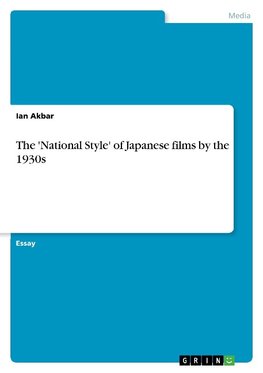
-
 Anglický jazyk
Anglický jazyk
The 'National Style' of Japanese films by the 1930s
Autor: Ian Akbar
Essay from the year 2016 in the subject Film Science, , course: ESL/EFL, language: English, abstract: This essay is an examination of Japanese film history up until the 1930s and reveals striking differences to that of the West. Silent films were the first... Viac o knihe
Na objednávku
9.27 €
bežná cena: 10.30 €
O knihe
Essay from the year 2016 in the subject Film Science, , course: ESL/EFL, language: English, abstract: This essay is an examination of Japanese film history up until the 1930s and reveals striking differences to that of the West. Silent films were the first variety of films to be shown in the 1890s, as they were in many countries. These films were largely influenced by the traditional Japanese performing art known as kabuki, which had a huge influence on films of this period, as did other forms of art.
Intrinsic to these early silent films was the presence of a physical narrator, the benshi. The benshi both resisted and had a lasting influence on sound films which began to be produced in the 1930s. In addition to the above, this paper will endeavour to demonstrate how Japanese cultural perceptions influenced the use of cinematic techniques largely derived from the West and produced a "national style" of film by the 1930s. In order to facilitate this discussion, Japanese film styles, the influence of reform and culture and exactly how cinematic techniques were put to different uses, as compared to the West, will be examined.
It is clear that the Japanese film up until the 1930s displayed a very characteristic "national style" which differed from the West. Silent films were largely influenced by the traditional Japanese performing art known as kabuki. Intrinsic to these early silent films was the presence of a physical narrator, the benshi, which has had a lasting influence to the present day.
Cinematic techniques were used in different ways and for different purposes. Early reform of the Japanese film industry, in addition, to making film more realistic and accessible for the working classes also allowed women to participate in film and for an entirely new genre of film to be created. The influence of the dramatic and visual arts has had a lasting influence on Japanese films up until the 1930s and has played a large part in the characteristic "national style" of Japanese film.
- Vydavateľstvo: GRIN Verlag
- Rok vydania: 2016
- Formát: Paperback
- Rozmer: 210 x 148 mm
- Jazyk: Anglický jazyk
- ISBN: 9783668333932







 Ruský jazyk
Ruský jazyk 



 Nemecký jazyk
Nemecký jazyk 
